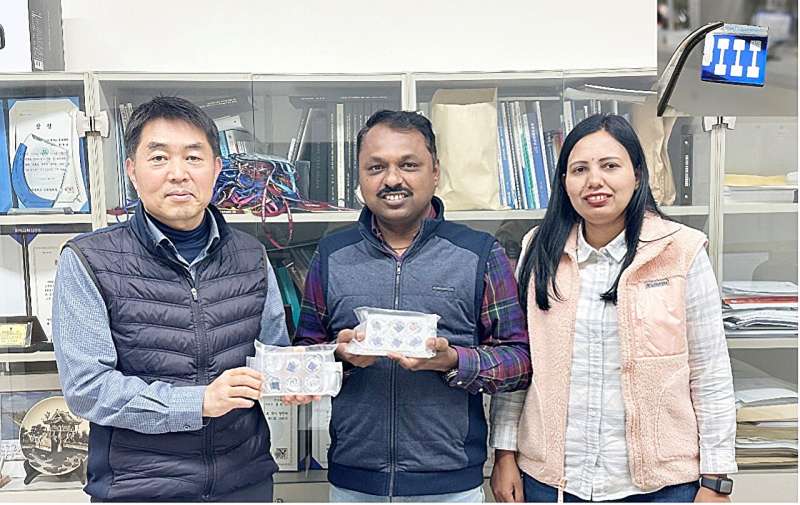December 16, 2023 feature
This article has been reviewed according to Science X's editorial process and policies. Editors have highlighted the following attributes while ensuring the content's credibility:
fact-checked
peer-reviewed publication
trusted source
proofread
New 'n-i-p' perovskite/organic hybrid tandem solar cells with efficiencies over 23%

Engineers and material scientists have been working to develop increasingly advanced photovoltaic solutions, to convert as much solar energy as possible into electricity and help to reduce greenhouse gas emissions. This has led to the introduction of various new solar cell designs, including all-perovskite tandem solar cells.
Researchers at Chonnam National University in South Korea recently introduced new monolithic perovskite hybrid tandem solar cells based on all-inorganic halide perovskites. These solar cells, introduced in a paper in Energy & Environmental Science, have achieved promising efficiencies of 23%.
"Single junction solar cell designs have some limitations, such as thermalization loss and transmission loss," Dr. Sawanta S. Mali, first author of the paper, told Tech Xplore. "To resolve these losses, we need to fabricate tandem solar cells, in which two absorbers like wide bandgap (WBG) and narrow bandgap (NBG) materials are stacked together with the help of suitable interconnecting layer (ICL)."
Previously introduced solar cell designs based on WBG materials achieved highly promising efficiencies. However, these cells are typically based on organic-inorganic hybrid perovskites, which are not thermally stable and thus compromise their overall performance.
Many of these solar cells are also fabricated using complex processes that would be hard to replicate on a large scale. These include, for instance, intricate sputtering and atomic layer deposition (ALD) techniques, which can be both difficult to implement and energy-consuming.

"In the case of NBG materials, many researchers previously used Pb-Sn-based NBG, which are suffering from serious degradation issues, such as Sn2+ to Sn4+ formation," Sawanta said.
"To avoid these issues, we developed all-inorganic perovskite-based WBG deposited in ambient conditions using our previously developed hot-air method and polymer bulk heterojunction (BHJ)-based NBG for fabrication of this monolithic two terminal 'n-i-p' hybrid tandem solar cells (2T-HTSCs). These cells can be fabricated using simple ICLs which are free from complicated sputtering or ALD process."
The primary objective of the recent work by Sawanta and his study was to realize thermally stable WBG materials that could be processed in ambient conditions and could be integrated into devices with a simple architecture, such as those with a so-called n-i-p configuration. Ultimately, they realized their all-perovskite materials using a hot-air assisted spin coating technique.
When integrated in hybrid tandem solar cells with an n-i-p architecture, these materials were found to lead to encouraging results. The resulting solar cells attained an efficiency of 23.07%, with an open-circuit voltage of 2.110 V, retaining more than 90% of their initial efficiencies for over 600 hours of operation at their maximum power.
"We implemented n-i-p device configuration and ambient air-processed approach which is simple and suitable for commercialization in the future," Sawanta said. "Since these 2T-HTSCs produce better efficiency than single junction with very high open circuit voltage (>2 V), we are eventually planning to implement these cells in artificial photosynthesis and agri-voltaic applications or Internet of things (IoT)."
In the future, the materials created by Dr. Sawanta S. Mali, Prof. Chang Kook Hong, and colleagues could be integrated in tandem solar cells with other designs, to further assess their potential. In addition, the fabrication approach employed by this team could be used by other teams to create other robust materials for photovoltaic applications.
"As part of our recent study, we only used double junction based tandem solar cells," Mali added. "In our next studies, we are planning to implement this concept in triple or multijunction tandem solar cells (MJ-TSCs) and their upscaling."
More information: Sawanta S. Mali et al, All-inorganic halide perovskites for air-processed "n–i–p" monolithic perovskite/organic hybrid tandem solar cells exceeding 23% efficiency, Energy & Environmental Science (2023). DOI: 10.1039/D3EE02763E.
© 2023 Science X Network



















